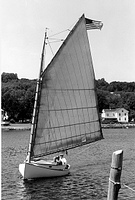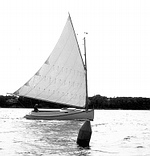A Catboat on the Hudson
If there could have been anything my father loved more than his family, it might have been his catboat Sea Duck, a Fred Goeller one-design of indeterminant age, most likely 1920 or thereabouts, which he sailed single-handedly along the great stretch of Nantucket Harbor, sometimes beaching on the smooth sands of Cotue to dig a few clams for his lunch or just scudding across the great expanse of water to be alone with the universe.
When he turned 81, he knew he no longer had the strength to take her out, and he gave her to me. Getting Sea Duck as a gift was an honor, I knew, but not being a sailor myself, I had no idea what I would do with her; I only knew that I live near a river that has marinas, and people do sail on the Tappan Zee. I took the plunge.
I joined the Catboat Association. I learned semaphore, I made nautical belts in needlepoint and I bought a pair of topsiders. My husband gave me sailing lessons and I learned to tie knots. I was determined to sail the Sea Duck on the Hudson and share this love of my father’s.
I learned quickly that catboats, once plentiful in our area, are now uncommon and an acquired taste. They don’t need any explanation on Cape Cod or the Islands where they are still being built and sailed, but down here on the Hudson, the memory of them has been nearly lost and not much respected. It was not always so.
A catboat is a beamy workboat that was numerous on the Hudson in the 19th and 20th centuries where its design is thought to have originated. It carries its single mast far forward and has a long boom jutting 3 feet or more past the stern. The single sail, usually gaffe-rigged, is enormous and has to be reefed in any fresh breeze. Catboats were especially well-suited to the river because of their retractable center board, allowing an adjustable draft of one to four feet for navigating the shallows.
An unseasoned or distracted catboat sailor can overcome the relative stability and safety of a catboat and get into trouble because it handles so differently from a keel boat. The huge sail and
shallow draft tend to weather helm (tipping the stem forward to dive into the deep) and require sufficient live ballast and expert handling to counteract.
There were many narratives in the New York Times during the height of the catboat era describing fatal accidents on the river caused by inattention to the characteristics of weather along the Palisades. First, the sudden squalls and winds resulting from turbulence from the Palisades make reefing at the first hint of wind imperative, and the tip of the long boom can dip into the water, capsizing it in a flash. There are also tales of heroic sailing in storms and fog and the pitch black of night and arriving safely in harbor.
Catboats are not now considered good racing boats yet the literature recounts a heyday of catboat racing in the 19th century when they routinely won regattas against keeled sloops. They could outmaneuver sloops by lifting their centerboards and skimming over reefs and flats that the sloops had to sail around. They could just go faster by sandbagging, the practice of rigging a catboat with an oversized sail and providing stability with moveable ballast, or sand bags, that crew had to continuously move about the boat to keep from capsizing.
Catboats had become a favorite of the wealthy men of the Hudson Valley and Long Island Sound in the 1870’s through the early 1900’s. There were yacht clubs up and down the river, in nearly every town of substance, many of whom were also represented at the New York Yacht Club and competed in its regattas. In fact, the newsletter of the Sing Sing Yacht Club from the 1890’s records many exhilarating races between catboats and sloops. Two of their champion racers were cats, the 25 foot Allar and the 22 foot Pauline B, both famous in their time. Catboats also played a political role as they resisted the advent of the steamship by ramming one whenever they could. They achieved the metal cladding of steamboats but were unable to halt their progress. The young Edward Hopper was nearly seduced into becoming a marine architect instead of a painter after he built a catboat in Nyack, and they can be found in many of his works.
Learning all this and excited by my new possession and all that it represented, I took my husband over to look at the Sea Duck. We lifted the heavy canvas holding puddles of water from previous rains. Dry leaves whirled in eddies on the floor of the cockpit, a hornet’s nest was visible aft. Paint and varnish were peeling and the cuddy doors were warped. All the pieces were there, the mast and boom and gaffe, the hoops, the barndoor rudder, the centerboard, the buckets and lines and sponges and gloves. My father had not put her away with his usual care and then had been unable to go back to her. Still, her graceful lines and quiet beauty transcended the neglect and we fell in love.
We had Sea Duck wooded down and restored and we brought her down to Piermont. Our marina harbored principally motor boats but it turned out that the two boats to the right of us were catboats and we noticed a third moored along River Road.
We maneuvered the Sea Duck out through the Piermont shallows onto the Tappan Zee. The wind caught her sail and she glided along with strength and grace as we knew she would. We listened to her gentle creaking and the water lapping against her sides. I trailed my hand in the water. Flying fish (could it be?) leaped into the air around us. The air, the light, the view took on a completely different quality out on the water. And I understood. This is what I will do with her, my Sea Duck. Run with the wind, scud along the waves, be at one with the universe.



